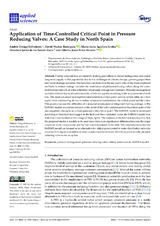Mostrar el registro sencillo del ítem
Application of time-controlled critical point in pressure reducing valves: a case study in North Spain
| dc.contributor.author | Ortega-Ballesteros, Andrés | |
| dc.contributor.author | Muñoz-Rodríguez, David | |
| dc.contributor.author | Aguilera Ureña, M. Jesús | |
| dc.contributor.author | de los Santos-Zarco, Francisco Javier | |
| dc.contributor.author | Perea Moreno, Alberto Jesús | |
| dc.date.accessioned | 2023-05-30T09:49:32Z | |
| dc.date.available | 2023-05-30T09:49:32Z | |
| dc.date.issued | 2023 | |
| dc.identifier.issn | 2076-3417 | |
| dc.identifier.uri | http://hdl.handle.net/10396/25424 | |
| dc.description.abstract | Potable water utilities are currently making great efforts to reduce leakage rates and assure long-term supply to the population due to the challenges of climate change, growing population and water shortage scenarios that have been on them over the last years. One of the most employed methods to reduce leakage includes the installation of pressurereducing valves along the water distribution network and the utilization of pressure management schemes. Pressure management includes different types of control models, which are applied according to the requirements of each site. The most advanced and sophisticated scheme is critical point control, which relies on a flow signal from a measuring device or online communication between the critical point and the valve. This paper proposes the utilization of a seasonal autoregressive integrated moving average, or the SARIMA model, to correlate pressure at the outlet of the valve and pressure on the critical point of the area supplied, aiming to set a fixed pressure in the critical point. The SARIMA model is developed according to historical data logged in the field and then validated. Later, the SARIMA model was tested on a real location in the village of Noja, Spain. The analysis of the field test results prove that the proposed model is feasible to be used since there is no significance difference between the target values set in the critical point and the real values measured in the field. The research proves that the SARIMA model can be used as an alternative for critical point control in water distribution networks when no flow signal is available or when communication between the critical point and the pressure reducing valve is not an option. | en |
| dc.format.mimetype | application/pdf | es_ES |
| dc.language.iso | eng | en |
| dc.publisher | MDPI | es_ES |
| dc.rights | https://creativecommons.org/licenses/by/4.0/ | es_ES |
| dc.source | Appl. Sci., 13(10), 5845 (2023) | es_ES |
| dc.subject | Pressure management | en |
| dc.subject | Pressure reducing valve | en |
| dc.subject | Critical point control | en |
| dc.subject | SARIMA model | en |
| dc.title | Application of time-controlled critical point in pressure reducing valves: a case study in North Spain | en |
| dc.type | info:eu-repo/semantics/article | es_ES |
| dc.relation.publisherversion | https://doi.org/10.3390/app13105845 | es_ES |
| dc.rights.accessRights | info:eu-repo/semantics/openAccess | es_ES |

